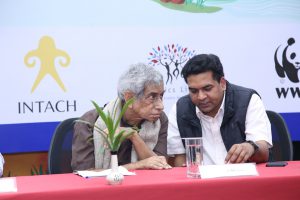On December 12, 2016 the World Bank was due to announce the appointment of both a Neutral Expert and the Chairman of a Court of Arbitration to resolve the outstanding disputes over the design features of the Kishanganga and Ratle hydropower dams located in the Indian state of Jammu & Kashmir. Instead, the President of the World Bank, in letters to the finance ministers of both India and Pakistan, announced a pause to the two processes.
The president of the World Bank, Jim Yong Kim, stated, “This is an opportunity for the two countries to begin to resolve the issue in an amicable manner and in line with the spirit of the treaty rather than pursuing concurrent processes that could make the treaty unworkable over time. I would hope that the two countries will come to an agreement by the end of January.” He was referring to the Indus Waters Treaty.
This was seen as a success by the Indian government, which has hailed the decision, as it had earlier warned the World Bank that the establishment of two concurrent processes was “legally untenable”.
The Indus Waters Treaty, signed in 1960, governs the sharing between India and Pakistan of water of the Indus rivers and is considered one of the most successful water-sharing agreements in the world.
See: World Bank drawn into Indus Waters Treaty dispute
Pakistan has reacted warily to the decision. There has been no official statement from the Foreign Office, and Sartaj Aziz, the adviser on foreign affairs to the Pakistani prime minister, has said that they would issue a statement after reviewing the World Bank’s statement. The sentiment is grim, though, as without the World Bank’s mediation any dispute would have to be negotiated bilaterally, which would negate the point of the treaty itself – since it is essentially a dispute resolution mechanism using a non-bilateral mechanism. It is this very mechanism that has now been called into account.
The heart of the problem is basically this: Pakistan believes that the Kishanganga and Ratle disputes need a Court of Arbitration to resolve the issue, while India believes that only a Neutral Expert – a lower level dispute mechanism – is necessary. In the history of the Treaty only one Court of Arbitration has been set up – but through a bilateral process and not through the World Bank – in 2010. This time the Indian government has refused to agree to a Court of Arbitration, and, in fact, it asked for a Neutral Expert to be appointed on October 4 this year, one and a half months after Pakistan requested setting up a Court of Arbitration on August 22.
While the World Bank has announced a pause until the end of January 2017, it is unclear what this will achieve without a way to bridge this difference. Earlier the World Bank had offered to provide a mediator to help sort through this issue, but neither country has yet indicated that it would be ready to go through this step. By Pakistan insisting on a Court of Arbitration, and India staunchly opposing this request, the Treaty has already stopped working as a dispute resolution mechanism. As a spokesperson for the World Bank told thethirdpole.net, whether the dispute is resolved through a Neutral Expert or a Court of Arbitration, both need the full cooperation of both governments. If either country is forced to accept a process they disagree with, they can simply hobble that process by not cooperating with it.
In the short-term this is in India’s favour, as it can continue to set the terms of engagement, but it is unclear what it means for the future. While the spokesperson for the Indian Ministry of External Affairs has said that India is fully conscious of its international obligations, this may not be the impression India is giving to its neighbouring countries. By initiating a competing process well after Pakistan had requested setting up a Court of Arbitration, India created the situation of two concurrent processes that it is now saying is legally untenable.
The headwaters of the Indus and Brahmaputra, the river systems that provide much of the fresh water for India’s north, lie in Chinese territory. No treaty or cooperation mechanism exists between the two large neighbours, and the Indus Waters Treaty is one of the few success stories of international water diplomacy in the region. It benefits no country if it falls into dispute.
![<p>President of the World Bank, Jim Yong Kim [image courtesy the World Bank Photo Collection]</p>](https://dialogue.earth/content/uploads/2016/12/Jim-Yong-Kim.jpg)






![Biomass burning is a major source of air pollution. [photo by Ahron-de Leeuw]](https://dialogue.earth/content/uploads/2016/12/Varanasi-ghat-Ahron-de-Leeuw-300x199.jpg)

